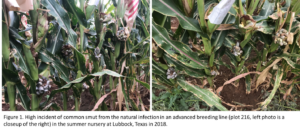Project Overview
Commodities
Practices
Proposal abstract:
This project will demonstrate the new corn genetics for huitlacoche and the associated management practices for promoting huitlacoche production, which will greatly enhance the value of the farmer’s crop. The two hybrids (“Huitla Maiz1”and “Huitla Maiz2”) for the SARE On-farm trial project are chosen for their overall agronomic performance, as well as susceptibility to common smut and therefore, high huitlacoche production potential (Figure 1). These parent lines of Huitla Maiz1 were developed by crossing temperate corn inbred lines and a Peruvian highland CUZCO variety, while these parent lines of Huitla Maiz2 were developed by crossing temperate corn inbred lines with its wild relative teosinte. These inbred lines and experimental hybrids were developed and selected for adaptation to the environments in southern United States, but they were not released due to their preserved poor trait of high common smut incident for grain production, which is now a superior trait for this project and future reliable and economic production of the huitlacoche delicacy. Both hybrids are non-GMO, therefore, they can be used for both conventional and organic crop systems.
The objective of this project is to conduct on-farm research and demonstrate the value of growing specialty huitlacoche corn as a new source of high-value delicacy crop and identify the best combination of hybrids with various soil types and environmental conditions. Development of a commercial corn hybrid may take 10 years and involve these major steps: (a) develop superior inbred lines with desirable traits, (b) make a number of experimental hybrids by crossing two inbred lines, (c) test the experimental hybrids in multiple environments for a few years and advance the best one for commercial production. Each step may take up to 5 years. Over the past 23 years, the PI (Xu) has developed numerous lines and hybrids by using exotic tropical corn germplasm and wild relatives such as teosinte and Tripscacum. Like other breeding programs, the majority of the breeding materials (inbred lines and hybrids) are discarded or stored in the cold room due to defective traits such the susceptibility to common smut. Considering that the diseased tissue (common smut) could become a high value delicacy, the shelfed germplasm findsa new use when their defect trait becomes a highly requested desirable trait.
Hybrids for the huitlacoche delicacy have already been developed, so this SARE grant will fund a system for integrating and establishing this technology on small farms. This new genetic technology can allow producers to generate income in small areas and help concentrate limited irrigation resources, conserve water resources, and increase crop diversity.
Project objectives from proposal:
Field experiments: We will grow and evaluate the performance of two hybrids (“Huitla Maiz1”and “Huitla Maiz2”) under two plant-populations on farmer’s fields in two widely-separated locations in Texas (Lubbock and Austin) as shown in Figure 2. These locations represent major metropolises and agriculture regions in Texas, have very diverse environments, and have a strong market for Mexican food.
Experiment corn hybrids: These hybrids are chosen for the SARE On-farm trial project according to their overall agronomic performance, but especially for susceptibility to common smut and therefore high huitlacoche production potential. These parent lines of Huitla Maiz1 were developed by crossing temperate corn inbred lines and a Peruvian highland CUZCO variety, while these parent lines of Huitla Maiz2 were developed by crossing temperate corn inbred lines with its wild relative teosinte. These inbred lines and experimental hybrids were developed and selected for adaptation to the environments in southern United States, but they were not released due to their observed poor trait of high common smut incidence negatively impacting grain production, but now becomes a superior trait for this project and future reliable and economic production of the huitlacoche delicacy. Both hybrids are non-GMO, and therefore, can be used for both conventional and organic crop systems.
Field experiment design: The experiment will use a split-split-plot design with three replications. The main plot is the plant population: medium at 20,000 plants per acre and high at 25,000 plants per acre, in order to determine which is the best hybrid-plant population combination for a specific farm. The sub-plot will be inoculation (with or without inoculation). The sub-sub-plots are the hybrids. Each plot will be two rows, 20-ft long, with a 30-inch row spacing.
Boost kit and application of Ustilago maydis inoculum: The farmer cooperators will receive a boost kit containing a 32 oz plastic sprayer bottle, a packet of dried spores of the fungus Ustilago maydis, and instruction of mixing the spore with water and sparing the spore solutions to the silks. The sprayer is adjustable from mist to steady stream. The bottle has graduated volume marks for ounces and milliliters. The original Ustilago maydis was collected from corn plants in Lubbock, Texas in November 2023. Dried smut tissues were stored in a sealed plastic bottle.
Data collection: Detailed records will be recorded on all farming inputs (such as fertilizers, hours for field operation, irrigation), rainfall, number of plants per plot, pollen shedding and silking dates, plant and ear heights. During the season, plants with huitlacoche will be marked by painting with an orange spray, huitlacoche will be harvested 15 days after inoculation. It is anticipated that some plants will produce huitlacoche before or after this target harvest date. The harvested huitlacoche will be counted and weighed. Ears without huitlacoche will give farmer additional income and will be harvested for grain by hand, shelled and weighed for grain yield. The total huitlacoche ears and grain yield and their sales value will be recorded to calculate the gross income and compare the profits of growing huitlacoche corn with other vegetables.
The seeds of the huitlacoche hybrids “Huitla Maiz1”and “Huitla Maiz2for farmers to grow are currently not available commercially. The PI and his staff will increase the seeds of the parent lines for the hybrids and produce the hybrid seeds through hand pollination and by using isolation seed production field. We are working closely with seed companies to commercialize the germplasm developed by our corn breeding program. New Deal Grain, a family-owned regional seed company in Texas, is very interested in licensing the parent lines of these hybrids.

